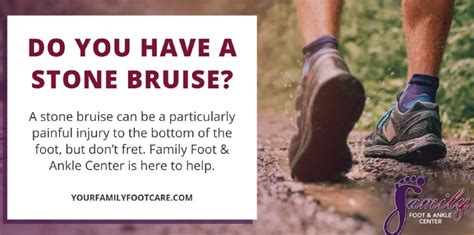Everything You Need to Know About Stone Bruise Healing
Stone bruises, also known as contusions, are common injuries resulting from a direct impact to the foot, typically from dropping a heavy object on it. Unlike a fracture, a stone bruise doesn't break the bone but instead causes damage to the soft tissues—the skin, fat pads, muscles, tendons, and ligaments—beneath the surface. This damage leads to bleeding and inflammation, causing significant pain and discomfort. This comprehensive guide will explore everything you need to know about stone bruise healing, from understanding the injury to effective treatment options.
What is a Stone Bruise?
A stone bruise is a specific type of contusion characterized by localized pain, swelling, and often discoloration in the foot. The impact crushes soft tissues, disrupting blood vessels and causing bleeding into the surrounding areas (hematoma). This trapped blood contributes to the swelling and pressure, intensifying the pain. The injury is often localized to a specific point on the foot, unlike more widespread contusions. The "stone" in the name refers to the feeling of a hard, tender spot under the skin.
What are the Symptoms of a Stone Bruise?
Identifying a stone bruise involves recognizing several key symptoms:
- Sharp, localized pain: This is often the first and most prominent symptom. The pain is usually focused on the point of impact.
- Swelling: The affected area will swell due to inflammation and blood accumulation.
- Discoloration: Bruising (ecchymosis) will likely develop, progressing from red or purple to blue, green, and eventually yellow as the blood is reabsorbed. The discoloration may be limited to a small area or spread slightly.
- Tenderness to the touch: The bruised area will be extremely sensitive to pressure.
- Difficulty walking or bearing weight: Depending on the severity, walking may be painful or impossible.
How Long Does a Stone Bruise Take to Heal?
The healing time for a stone bruise varies significantly depending on factors like the severity of the injury, the location on the foot, and individual healing capabilities. Generally, expect healing to take several days to several weeks. Minor bruises might heal within a week, while more severe injuries could take several weeks or even a month. Pain and swelling usually subside gradually.
What Factors Affect Healing Time?
- Severity of the impact: A more forceful impact leads to more extensive tissue damage and a longer healing time.
- Location of the bruise: Bruises on weight-bearing areas of the foot (like the heel or ball of the foot) tend to take longer to heal.
- Individual health and age: Overall health, age, and pre-existing conditions can influence the healing process.
How to Treat a Stone Bruise
Treating a stone bruise focuses on managing pain, reducing swelling, and promoting healing. Here's a comprehensive approach:
RICE Method:
The RICE method is a cornerstone of stone bruise treatment:
- Rest: Avoid activities that put pressure on the injured area. This means limiting walking or using crutches if needed.
- Ice: Apply ice packs wrapped in a thin towel for 15-20 minutes at a time, several times a day. This helps reduce swelling and pain.
- Compression: A compression bandage can help minimize swelling and provide support. Avoid wrapping it too tightly, as this can restrict blood flow.
- Elevation: Keep your foot elevated above your heart whenever possible. This helps reduce swelling by promoting drainage.
Over-the-Counter Pain Relief:
Nonsteroidal anti-inflammatory drugs (NSAIDs) like ibuprofen or naproxen can help manage pain and inflammation. Follow the recommended dosage on the packaging.
Other Treatments:
- ** Epsom salt soaks:** Soaking the affected foot in warm Epsom salt water can help reduce swelling and pain.
- Topical pain relievers: Creams or gels containing menthol or lidocaine can provide localized pain relief.
When to See a Doctor
While most stone bruises heal with home treatment, it's crucial to see a doctor if:
- The pain is severe or unbearable.
- You suspect a fracture or other serious injury.
- There is significant swelling or discoloration.
- Numbness or tingling develops in the foot.
- The pain doesn't improve after a week or two of home treatment.
What are some preventative measures for Stone Bruises?
Preventing stone bruises involves protecting your feet from impact injuries. Consider these steps:
- Wear protective footwear: Appropriate footwear, especially steel-toed boots in industrial settings, can significantly reduce the risk.
- Handle heavy objects carefully: Always lift heavy objects using proper lifting techniques to avoid dropping them on your feet.
- Be mindful of your surroundings: Pay attention to uneven surfaces or potential hazards that could cause you to trip or fall.
What's the difference between a stone bruise and a fracture?
While both can cause pain in the foot, they are distinct injuries. A stone bruise damages soft tissues, while a fracture involves a break in the bone. A fracture will usually result in significantly more severe pain, inability to bear weight, and possible deformity. X-rays are used to definitively diagnose a fracture.
Can I exercise with a stone bruise?
Avoid activities that put pressure on your injured foot until the pain and swelling have subsided. Gentle range-of-motion exercises might be helpful once the acute phase has passed, but always consult with a healthcare professional or physical therapist.
Are there any home remedies to heal a stone bruise faster?
While the RICE method and over-the-counter pain relievers are effective, there's no guaranteed way to significantly speed up the natural healing process. Focus on consistent application of these strategies for optimal results.
This article provides general information and does not constitute medical advice. Always consult with a healthcare professional for any health concerns or before starting any new treatment plan.

